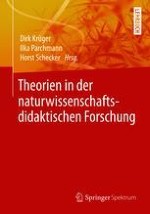2018 | OriginalPaper | Chapter
15. Interesse und Interessenentwicklung
Authors : Dr. Janet Blankenburg, Prof. Dr. Annette Scheersoi
Published in: Theorien in der naturwissenschaftsdidaktischen Forschung
Publisher: Springer Berlin Heidelberg
Activate our intelligent search to find suitable subject content or patents.
Select sections of text to find matching patents with Artificial Intelligence. powered by
Select sections of text to find additional relevant content using AI-assisted search. powered by
